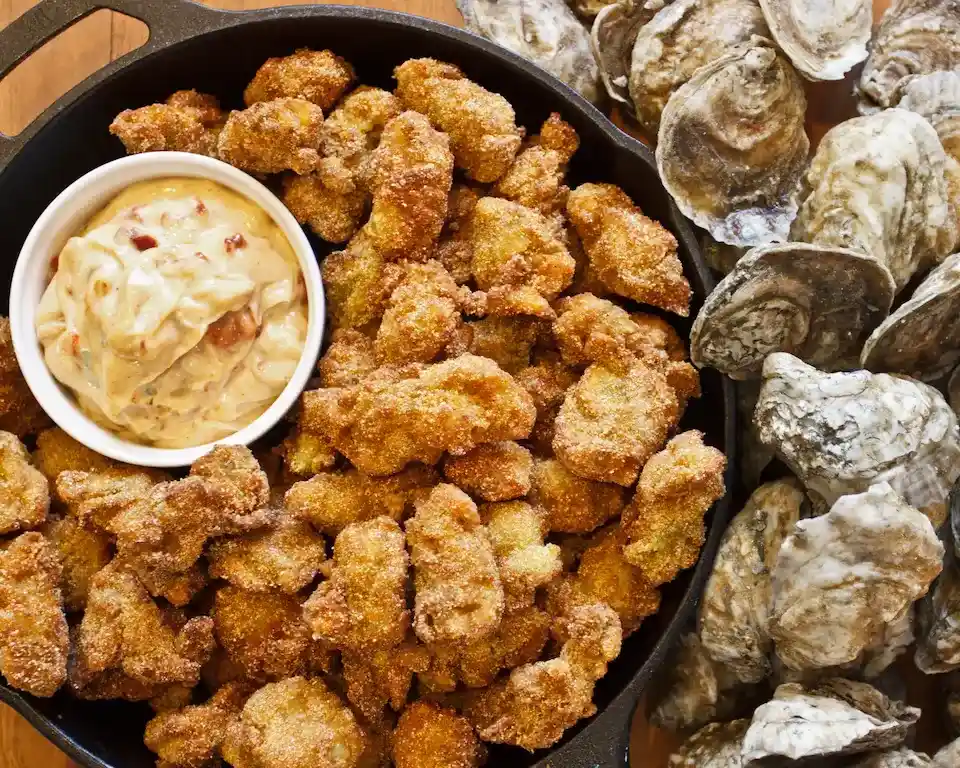When it comes to culinary delights from the sea, few offerings can rival the exquisite and briny indulgence of oysters. These delectable bivalves have long held a special place in the hearts and palates of seafood enthusiasts around the world. When it comes to oyster season, it’s difficult to not indulge in these meaty sea creatures. Yet, there’s always been a lingering mystery about oysters, a seasonal rhythm that has guided their consumption for generations.
You may have heard of the “R Months Rule,” which advises us to enjoy oysters only during months with an ‘R’ in their name. However, in our ever-changing world of food production and consumption, does this age-old rule still hold true? Join our North Carolina seafood experts on a journey through understanding oyster season. Whether you’re an oyster aficionado or a curious diner, prepare to discover the secrets behind oyster season and the ever-evolving world of these oceanic delicacies.
Debunking Oyster Season Myths
Oysters, those briny and delectable bivalves from the sea, have long been celebrated as a delicacy fit for both kings and commoners. Their unique flavor and texture have made them a favorite among seafood aficionados around the world. However, like many cherished foods, oysters have also accumulated their fair share of myths and misconceptions over the years.
Myth 1: You Should Only Eat Oysters in Months with the Letter ‘R’
While the R Months Rule may have had some validity in the past, it is no longer a strict guideline to follow. In the days before modern refrigeration and transportation, oysters were indeed more susceptible to spoilage during the summer months. However, with today’s technology and stringent safety regulations, oyster season can extend as oysters can be enjoyed year-round without concern for their freshness or safety. Your summer seafood recipes can include oysters as long as they are fresh and obtained by reputable sources.
One of the most persistent myths surrounding oysters is the “R Months Rule.” According to this traditional guideline, oysters should only be consumed during months that contain the letter ‘R’ in their name. That means you’re supposed to indulge in oysters from September through April but avoid them during the warmer months of May through August.
Myth 2: Raw Oysters are Unsafe to Eat
The fear of consuming raw oysters is a common concern among many people. Some worry about the risk of foodborne illnesses, particularly due to bacteria like Vibrio vulnificus, which can thrive in warm waters and infect oysters. While there is a legitimate concern about the safety of raw oysters, it’s important to understand that the risk can be mitigated with proper handling and sourcing.
Oyster harvesting and distribution are highly regulated to ensure safety. Reputable oyster farms follow strict guidelines to ensure their oysters are harvested from clean and monitored waters. Always choose oysters from trusted sources to reduce the risk of contamination. However, from trusted and reputable seafood providers, raw oysters are a welcome addition to seafood platters and other raw preparations.
Myth 3: Oysters are Always Best Consumed Freshly Shucked
There’s a common belief that oysters should be consumed immediately after shucking to enjoy them at their finest. Some even claim that oysters start to lose their flavor and quality within minutes of being shucked. While freshly shucked oysters are undoubtedly a culinary delight, it’s not always necessary to consume them immediately after shucking. Oysters can be enjoyed at their best if they are shucked shortly before serving, but they can still retain their quality for a reasonable period when handled and stored correctly.
Myth 4: Cooking Oysters Ruins Their Flavor
Some seafood purists believe that cooking oysters is sacrilegious and that it destroys their delicate flavors. They argue that oysters are best enjoyed raw to fully appreciate their natural taste. While raw oysters certainly have their appeal, cooked oysters can offer an entirely different culinary experience that is equally delightful. Cooking oysters can enhance their flavors and provide a unique twist to their texture, whether grilled, baked, fried, or steamed, oysters can be delicious as the result of various preparation methods.
Choosing Farmed vs. Wild Oysters
In the world of oyster consumption, two distinct varieties grace our plates during oyster season: farmed and wild.
What Are Farmed Oysters?
Yet, the allure of wild oysters comes with its set of challenges. Seasonal availability is one such hurdle– wild oysters follow the rhythm of nature, which means they might not be accessible year-round. Additionally, overharvesting wild oyster populations can lead to habitat destruction and declining numbers, raising concerns about their environmental impact. Safety is another consideration, as wild oysters can carry a higher risk of contamination with pathogens or pollutants.

Farmed oysters, as their name suggests, are cultivated in controlled environments, often within aquaculture farms or designated beds. This controlled environment translates to predictability in terms of size, texture, and flavor, which chefs and seafood lovers appreciate. Farmed oysters offer the convenience of year-round availability, ensuring a steady supply for our culinary delights. Moreover, farmed oysters are often viewed as a sustainable seafood option due to the ability to minimize their impact on natural oyster populations through responsible farming practices.
However, some argue that farmed oysters might lack the distinctive regional flavors and terroir that wild oysters can offer. Critics contend that the controlled conditions may alter the natural characteristics of these bivalves, potentially missing out on the unique attributes shaped by their native waters. Still, the reliability and reduced environmental impact of farmed oysters make them a compelling choice during oyster season.
What Are Wild Oysters?
Wild oysters, in contrast, live and thrive in their natural habitats—coastal estuaries, bays, or reefs—relying on the ebb and flow of nature for their growth and survival. This wild existence of wild oysters infuses them with a range of flavors influenced by the specific local water conditions, creating a true taste of place. Those who relish culinary adventures often turn to wild oysters for their unique and sometimes surprising flavors. Their deep-rooted cultural and historical significance in many coastal communities adds to their allure.
Choosing Between Farmed vs Wild Oysters
The choice between farmed vs wild oysters often boils down to personal preference, culinary objectives, and ethical considerations. Whether you opt for the consistency and sustainability of farmed oysters or the unique flavors and traditions of their wild counterparts, both varieties contribute to the rich tapestry of seafood and culinary experiences.
What Are Triploid Oysters?
Oysters have long been revered for their delectable brininess and the culinary experiences they offer, but what if there were a way to enhance their attributes, elevating these already cherished bivalves to an even higher level of culinary delight? Enter the world of triploid oysters– a remarkable innovation that has revolutionized oyster farming and dining experiences.
Understanding Triploid Oysters
Traditionally, oysters are diploid, meaning they possess two sets of chromosomes, one from each parent. This diploidy plays a significant role in their reproductive cycle. Triploid oysters, however, are a genetic variation created through a process known as triploidy induction. In this process, oysters are exposed to specific environmental conditions or treatments that result in the development of a third set of chromosomes. This genetic alteration renders them sterile and unable to reproduce.
The most notable feature of triploid oysters is their inability to reproduce. Because they lack functional reproductive organs, they do not spawn, ensuring that all their energy is directed toward growth and meat development. Triploid oysters often exhibit superior meat quality compared to diploids. They tend to have plumper, more succulent meat, making them highly desirable for consumption.
The Culinary Delights of Triploid Oysters
One of the primary reasons triploid oysters have gained popularity among chefs and seafood enthusiasts is their culinary excellence. The enhanced meat quality of triploids translates into a more satisfying and flavorful oyster-eating experience. Their plump, tender meat bursts with the briny essence that oyster connoisseurs crave.
Triploid oysters are prized for their versatility in the kitchen. Whether enjoyed raw, grilled, baked, fried, or incorporated into complex seafood dishes, they retain their superior texture and flavor. Their larger meat-to-shell ratio means you get more succulent meat with each bite, making them an ideal choice for oyster aficionados seeking a premium dining experience.
Where to Find Triploid Oysters
As the popularity of triploid oysters continues to grow, you can find them on the menus of seafood restaurants and oyster bars around the world during oyster season. Many oyster farms now specialize in producing triploids to meet the increasing demand from chefs and consumers who appreciate their superior meat quality and dining experience.
Sign Up for NC Seafood’s Monthly Newsletter and Enjoy Fresh Seafood Throughout Oyster Season
Are you passionate about seafood, eager to stay updated on the freshest catches, and hungry for exclusive offers? Join our growing community of seafood aficionados by subscribing to the NC Seafood Monthly Newsletter. By signing up on the form below, you’ll unlock a world of culinary delights and seafood expertise delivered right to your inbox once a month.
Whether you are interested in the latest seafood and oyster season news or looking for a great place for fried seafood in North Carolina, NC Seafood has you covered.
To stay connected with us, sign up for our monthly newsletter. Or, come visit us at the Raleigh Farmer’s Market any day of the week. We look forward to seeing you soon!
